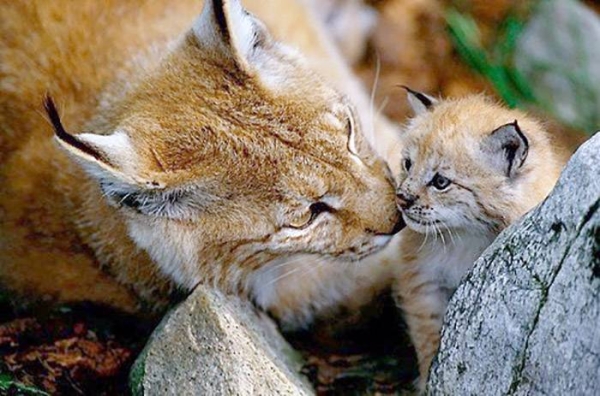
The maverick rewilder Derek Gow is wearing an extremely small pair of coral pink shorts as he introduces his three new Eurasian lynxes. He looks like Tiger King’s Joe Exotic on the wrong side of the Atlantic.
The shy new arrivals are joining a menagerie of animals at his rewilding project in Devon. They are in a large pen with a four-metre-high fence but Gow, like a growing number of conservationists, wants to see lynxes prowling freely in the countryside.
Surrounded by buttercups, thistles and long grass, it is hard to believe these exotic-looking cats are native to the UK and lived here for thousands of years. The black lines around their green eyes give them the air of an Egyptian pharaoh. In the two hours spent watching them, one climbs a willow tree, kills a blackbird, then eats it in the long grass. They squawk like crows, play in the water and are a delight to watch.
Gow does not want to let these specific cats out. They are from a UK zoo and far too tame, he says. Instead, he wants people to come and learn about them. “This is about starting conversations that might actually go somewhere. Because I’m done with talking for the sake of fucking talking,” he says. Gow thought he was getting three females but “two arrived with testicles”, he says with characteristic frankness.
Lynxes, known as Britain’s little lions, survived in Yorkshire until the sixth century AD. Their bones have been found in caves all over the country yet the Shropshire village of Lostford (“ford of the lynx” in Old English) is believed to be the only lynx-associated name in the country. Europe’s two largest predators, bears and wolves, appear frequently in folklore and fairytales. Yet the third largest predator, the lynx, is missing.
This is because they are solitary, shy creatures that ambush their prey, unlike wolves, which hunt in packs. People rarely saw them, and it turns out they survived in Britain in secret for thousands of years longer than previously thought. Britain’s lynxes disappeared because of habitat loss and persecution by humans and many think we have a moral obligation to correct that. On the other side of the argument are those concerned that the lynx would be a deadly threat to livestock and pets.
Reintroducing a wild cat into an environment 500 years after it became extinct is complex. Giving people good-quality, reliable information about the species is a precursor to a successful reintroduction, and so far the debate has been impassioned and polarised, says David Hetherington, author of The Lynx and Us, and an ecologist working in the Cairngorms national park.
“I think it’s important to gauge public feeling rather than putting out garish newspaper headlines about how they’re going to do it all tomorrow,” he says.
Where do Europe’s lynxes live?
Like wolves, Eurasian lynx populations are naturally returning all over Europe since becoming a protected species after centuries of persecution by humans and clearance of their woodland habitat. During the 1950s there were just 700 in Europe; now there are about 9,000.
In the 1960s, environmentalists started to recognise the importance of the lynx in forested landscapes, according to Hetherington’s book. They have naturally recolonised territories in Scandinavia, the Baltic states, western Russia and the Carpathian mountains thanks to acceptance by local people, an increase in forest cover and growing populations of deer (their main food source).
In central and western Europe, landscapes are more fragmented and heavily farmed, crisscrossed with roads and urban areas that have hindered natural recolonisation by the lynx. Recognising this, conservationists started reintroductions in the 1970s, establishing populations in Switzerland, Slovenia, the Czech Republic and France. The lynxes then naturally spread into Italy, Austria, Croatia and Bosnia-Herzegovina. Reintroducing lynxes is less problematic than reintroducing wolves because they do not hunt in packs and like to stay hidden in woodland.
Projects in Germany and Austria failed mainly because of illegal hunting, which remains a problem, even in countries that have successfully reintroduced the lynx.
What is the argument for reintroducing lynxes to the UK?
One way lynxes enrich forest ecosystems is by increasing the availability of carcasses. They mainly hunt deer but they cannot eat a whole animal in one go. They eat a bit and then hide it, often burying it under leaves or snow. It can take up to a week to eat the entire carcass.
In the meantime, wolves, wolverines, bears, foxes, badgers, pine martens, polecats, wild boar and wildcats will feast on it, keeping clear of the lynx usually lurking a few hundred metres away. Raptors such as white-tailed eagles, buzzards and kites also benefit. Research in Poland found that birds and mammals scavenged 80% of carcasses buried by lynxes.
Animals further down the pecking order, such as small woodland mammals and birds, also get a piece of the prize before the remains rot, which in turn enriches ecosystems in the soil.
In Scotland, vast numbers of deer are causing widespread ecological damage. A report last year said Scottish Forestry spent £4.7m a year on reducing the impacts of deer on woodland – more than three times the £1.5m that Scottish Natural Heritage spends on deer management annually. Reintroducing lynxes could help reduce deer populations, which would increase natural woodland regeneration.
But while lynxes are a keystone species, they will not radically change landscapes as beavers do, and would not be suited to living in all parts of the country. They are solitary ambush hunters. Each animal generally has a territory of at least 100 sq km and cats of the same sex do not like to share territories. Landscapes cannot support a high density of them.
Why wouldn’t we want lynxes?
The lynx’s dietary preferences can get it into trouble – their appetite for sheep is a serious concern for farmers. However, evidence from countries with landscapes similar to the UK suggests that the number of sheep casualties would be relatively small. Sheep in Europe mostly graze in open pasture where lynxes do not generally hunt.
Switzerland, for example, is home to about 300 lynxes, which kill between 20 and 50 sheep a year, and about 12,500 roe deer and chamois. Licences are given out to kill problematic lynxes, but there have been none issued since 2003. The last lynx killed was from poaching five years ago.
One country where rates are significantly higher is Norway. This is because as many as 2.5 million sheep graze freely in woodlands during the summer months and there are relatively few deer, Hetherington found. Farmers claim compensation for up to 10,000 sheep deaths a year, though an independent assessment by scientists suggests lynxes could not possibly be responsible for all of them.
“Although the UK has the biggest sheep population in Europe, the vast majority of sheep are raised in open pasture,” says Hetherington, who did his PhD on the feasibility of reintroducing lynxes to Scotland. “Most forests contain no sheep but they have lots of deer. All of which would suggest we would have a relationship with lynx that is most likely to replicate what we see in Switzerland.”
Where could they be reintroduced in the UK?
Lynx UK Trust believes Kielder forest in Northumberland is the most suitable place to reintroduce lynxes because it is a large forested area, has few roads and lots of deer. However, local people are divided over this contentious issue and at the end of 2018 a trial application was turned down by the Department for Environment, Food and Rural Affairs after advice from Natural England raised concerns.
In January, in a separate project, conservationists launched a year-long study, Lynx to Scotland, to ask farmers, landowners and local communities what they thought about reintroducing lynxes. If they respond positively, a pilot project could be launched, with up to 40 lynx released in five years around forested Highland estates in the Cairngorms. If the public is not keen, organisers say the project will be dropped.
Hetherington believes southern Scotland and Kielder forest could support about 50 lynxes in total, and the Highlands could support 400. His research suggests Scotland has more than 20,000 sq km of suitable habitat for lynxes. The less-populated parts of the UK are better suited to lynxes because roads are a significant cause of mortality and affect a population’s ability to colonise new landscapes.
In Northumberland, James Copeland, the National Farmers’ Union (NFU) north-east environment adviser, says the Lynx UK Trust has not taken into account the concerns of farmers and local people in Kielder forest, many of whom are anxious about the thought of lynxes prowling around the countryside.
“The evidence and information presented to [our members] hasn’t given them any level of assurance, so they’re left with a position that they can only object. If further activity and further assurances were presented to them, we would take another sounding from our members,” says Copeland.
Concerns include the risk of livestock being killed by lynxes, how to stop them escaping from a trial release site, and also an exit strategy, with proper financing, if it all went wrong. NFU members also want a special lynx taskforce to be created by Natural England so farming communities can easily raise any worries they may have.
During lockdown, discussions have taken place online. But, says Copeland, NFU member have been unable to join in the debate because rural broadband is so poor. “Certainly there are ways of doing consultation events to ensure that you raise awareness and local buy-in, and as of yet, we haven’t seen anything that has demonstrated that.”
Paul O’Donoghue, director of Lynx UK Trust, declined to comment.
NFU Scotland president Martin Kennedy says that in the past three to four years rewilders have made “a long line of brazen and presumptuous claims”.
“Any proposals to reintroduce predators such as lynx, wolves or bears would be wholly unacceptable to Scottish farmers and crofters,” he argues.
What next?
Successful reintroductions of lynxes rely strongly on them being accepted into the landscape by the humans they share it with. Making space for the lynx in the UK is more a question of attitude than habitat availability. The Swiss reintroduction is a cautionary tale. It was resisted by many people and the illegal killing of lynxes continues to be a serious problem, threatening the long-term viability of the population.
Hetherington says lynxes could be reintroduced in five to 10 years. Gow does not want to give a date and is more cautious, saying lots of people in the UK remain strongly against it. But both agree that there are risks as well as opportunities to reintroducing lynxes, and winning over those people with reasonable doubts should be a priority.
Natural England confirmed there were currently no applications to reintroduce lynxes to the wild. Any plan for reintroduction would consider the socio-economic effects as well as the impact on the animals themselves.












